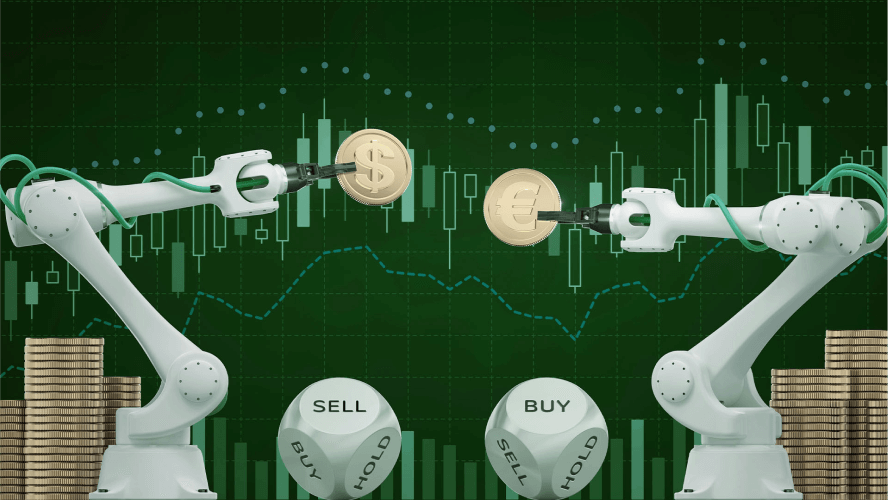Forex stands for foreign exchange. Trading forex means trading currencies from around the world – think Euros, Pounds, Dollars, Yen, Pesos, and others. The value of a currency can only be expressed in another currency or in the value and quantity of an asset it can buy. Due to different economic factors, the values of foreign currencies are constantly changing relative to one another, presenting an opportunity to profit from trading them.
Currencies each have their own 3-letter code: for example, the American dollar is expressed as USD, and the British Pound is expressed as GBP. Since you are trading between them, forex is always traded in pairs: EUR/USD, NZD/JPY, GBP/AUD, etc.
Unlike stocks, forex assets don’t have one authoritative price. Forex prices are determined by banks and vary a bit, though they tend to be around the same due to stiff competition.
With no central forex marketplace, currency trading is performed electronically over-the-counter (OTC), meaning forex assets are not listed on an exchange and dealers trade directly via computer. Currencies are traded worldwide across most time zones in the major financial centers of London, New York, Tokyo, Zurich, Frankfurt, Hong Kong, Singapore, Paris and Sydney. Therefore, the market is open 24 hours a day 5 and a half days a week.
And you thought you didn’t sleep enough!
The forex market is the largest, most liquid financial market in the world, with a daily average volume of $5.1 trillion a day as of April 2016. The size and magnitude of the forex market also makes it so no one player or bank can manipulate it, unlike with the cryptocurrency market, for example.
Forex brokers offer several ways of trading international currencies, three of which are: options trading, futures trading, and CFDs (Contracts for Difference). Forex futures contracts are when two parties agree to buy or sell currency at a set date, time, and contract size. Forex options trading are like futures contracts, only the trader doesn’t have the obligation to fulfill the terms initially set at expiration. Though this limits a trader’s downside risk, forex options contracts generally have higher trading fees than forex futures contracts.
A contract for difference (CFD) is a derivative contract and essentially acts as a futures contract made between the broker and the trader in which the settlement of the contract is made in cash rather than the physical delivery of goods or securities. When trading using a CFD, you will earn (or lose) depending on the difference in price between the moment you entered the contract and the moment the contract ends. CFDs allow traders to trade on many more assets and markets than traditional contracts, as well as allowing users to profit from a bear market by placing sell/short orders.
If you want to start automating your forex CFD trading, look no further than Capitalise. Integrated with Interactive Brokers, one of the largest forex brokers out there, using the Capitalise automated trading software is the easiest and fastest way to automate your trading strategies. Plus, Capitalise will be integrating with many more brokers soon, so you will have even more options as to where you can automate your trades.
Automating your trading strategies may sound scary and like it requires coding but with Capitalise, it doesn’t. All you have to do is write if-then strategies in plain English and Capitalise takes care of the rest, monitoring the market and executing your trades from entry to exit.
To open a forex algo trade on Capitalise, simply select an action like BUY or SELL and then write the market scenario that will lead to the triggering of that action.
For example: Buy 1000 units of EURUSD if the price of EURUSD is above last day high
You can reference fundamental indicators such as news events and technical indicators such as Bollinger Bands, the MACD, and Moving Averages as part of a condition or market scenario in a strategy.
Whether you already have a solid trading plan or you’re just starting out, Capitalise empowers you to automate your own forex trading strategies.
You can start with simple, condition-free strategies such as “Buy 1000 EUR/USD“, which will send an order to your broker to buy 1000 units of EURUSD on the spot. From there, you can start creating strategies with 1, 2, or even 10 conditions.
For example:
Market Entry: Buy 1000 EUR/USD if the MACD line of EUR/USD crosses above the signal line
Market Exit: Close position at profit of 5% or at loss of 5% or with a trailing stop loss of 5%
In this case, the strategy will check when the MACD line crosses over the signal line and at that point it will send an order to BUY 1000 units of EURUSD. Once the order is executed, Capitalise will monitor the market for the exit conditions described in the Exit strategy.
All you need to do is sit down, relax, and let Capitalise do the work for you
When automating your forex trades on Capitalise through Interactive Brokers, you’ll benefit from hands-off execution of your strategy exactly as you want it done. So while the forex market barely sleeps, you can get the shuteye needed to think up the next great strategy. Where can you get started, you ask? Just go to https://app.capitalise.ai/wizard and start typing.
Please note that the examples we provided here are purely for the purposes of illustrating how to automate your forex trading using Capitalise and are not in any way to be taken as trading advice. This content is intended for information and educational purposes only and should not be considered investment advice or investment recommendation. Past performance is not an indication of future results. Read more here
